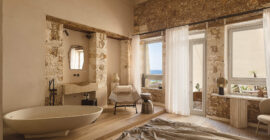Reflections of the past
The project showcases a private residence in Amsterdam that maximizes its available floor space. Located in the vibrant De Pijp district, the building’s upper floor was previously an attic, unsuitable for habitation.
Existing Shell
In order to transform this space into a livable area, the previous owner raised the roof by approximately fifty centimeters before selling it as a renovation project to the current owner. The roof elevation was achieved by constructing a ring of rough masonry around the original structure and laying largely renewed roof beams on top. This approach -creating a new level on top of an old foundation- became the guiding principle of the design. The space is deliberately “cut through” at a height of 95cm above the floor, establishing a clear visual and material distinction. Above this cross-section, everything is new, featuring smooth, insulated, and rendered walls. Below the line, the original elements are left exposed, preserving their raw, unfinished aesthetic.

Material Palette & Functional Layout
The material interplay, such as dark mirrors, rough bricks, and unfinished zinc sheets, creates a striking composition. The zinc panels reflect ample light but with a soft, blurred effect, while the dark mirrors offer sharp reflections with less luminosity. This duality presents the upper section as a reimagined space and the lower section as a reflection of its past.
Upon entering the apartment, visitors step into a fully black-painted hall. The original staircase remains raw and unfinished, while a custom perforated zinc staircase hangs 95 centimeters above the floor, leading to the roof terrace. Light from the roof hatch filters through the perforations, illuminating the dark entrance below. At the top of the stairs, the living room draws the eye outward through a floor-to-ceiling sliding glass door, spanning the entire width of the building. The concealed framing within the walls, floor, and ceiling creates an almost frameless glass facade, replacing the previously small windows.
To enhance the perception of space, the design introduces a single defining volume within the apartment. While the living area and master bedroom remain open, all other functional spaces -including bathrooms, a guest room, a laundry area, and toilets- are concealed within a reflective, monolithic block. A pivot door, finished in the same materials, allows seamless access. One section of the mirrored cladding is actually reflective glass, offering a semi-transparent view from the living room into the bathroom. A skylight above the shower creates the unique experience of bathing beneath an open sky, flooding the space with natural light.

Sustainability Approach
The fully retractable glass facade on the southern side of the apartment provides passive heating. The 17cm floor insulation, insulated walls, and externally insulated roof maintain a stable indoor climate. A single, large net curtain can cover the entire rear facade, hanging from curved rails that allow it to be drawn without obstructing sunlight. Furthermore, an electric roof hatch above the entrance can be opened on hot days, aiding airflow. The perforated zinc staircase beneath the hatch reflects sunlight, while the ability to release warm air at the highest point of the space creates natural ventilation. This concept, inspired by tropical architecture, ensures the residence stays cool in summer while superior insulation minimizes heat loss in winter. Consequently, the apartment’s gas consumption for heating is just one-fifth that of a conventional apartment.






